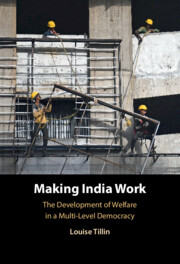Refine search
Actions for selected content:
406 results
1 - “We Are Not Immune”
-
- Book:
- Risk and Resistance
- Published online:
- 10 September 2025
- Print publication:
- 09 October 2025, pp 9-32
-
- Chapter
- Export citation
2 - Litigating Risk
-
- Book:
- Risk and Resistance
- Published online:
- 10 September 2025
- Print publication:
- 09 October 2025, pp 33-60
-
- Chapter
- Export citation
6 - Implications for Effective Policy
-
- Book:
- Building Social Mobility
- Published online:
- 15 September 2025
- Print publication:
- 02 October 2025, pp 147-164
-
- Chapter
- Export citation

Armed Citizens and Citizens in Arms
- The Military and the Creation of the State of Peru, 1800‒1860
-
- Published online:
- 12 September 2025
- Print publication:
- 25 September 2025
Primacy of Property as Devolution of Rights: Case of Women in India through the Lens of Inheritance Laws
-
- Journal:
- Asian Journal of Law and Society , First View
- Published online by Cambridge University Press:
- 01 August 2025, pp. 1-16
-
- Article
- Export citation
Welfare Subjects and Autopoiesis
-
- Journal:
- Journal of the American Philosophical Association , First View
- Published online by Cambridge University Press:
- 17 July 2025, pp. 1-19
-
- Article
-
- You have access
- Open access
- HTML
- Export citation
Chapter 8 - Isolation, Indifference and Suspicion
-
- Book:
- Emigrant Soldiers
- Published online:
- 05 June 2025
- Print publication:
- 26 June 2025, pp 165-184
-
- Chapter
- Export citation
Cross-jurisdictional youth employment policy and welfare in Scotland, Wales and England: a street-level perspective
-
- Journal:
- Journal of Social Policy , First View
- Published online by Cambridge University Press:
- 13 June 2025, pp. 1-20
-
- Article
-
- You have access
- Open access
- HTML
- Export citation
Inferring welfare from inconsistent choices: how values matter
-
- Journal:
- Economics & Philosophy , First View
- Published online by Cambridge University Press:
- 19 May 2025, pp. 1-24
-
- Article
-
- You have access
- Open access
- HTML
- Export citation
Stamp duty and spatial misallocation
-
- Journal:
- Macroeconomic Dynamics / Volume 29 / 2025
- Published online by Cambridge University Press:
- 24 April 2025, e96
-
- Article
-
- You have access
- Open access
- HTML
- Export citation
Just Say No: The Diffusion of Drug Testing for Welfare Proposals across US States
-
- Journal:
- State Politics & Policy Quarterly / Volume 25 / Issue 3 / September 2025
- Published online by Cambridge University Press:
- 14 April 2025, pp. 282-299
- Print publication:
- September 2025
-
- Article
-
- You have access
- HTML
- Export citation
Affirmative Action Policies Under the Postwar Japanese Constitution: On the Effects of the Dōwa Special Measures Policy
-
- Journal:
- Asia-Pacific Journal / Volume 16 / Issue 5 / March 2018
- Published online by Cambridge University Press:
- 14 March 2025, e4
-
- Article
-
- You have access
- Open access
- Export citation
China's Old Working Class: Impoverished and Cast Aside
-
- Journal:
- Asia-Pacific Journal / Volume 20 / Issue 15 / August 2022
- Published online by Cambridge University Press:
- 14 March 2025, e1
-
- Article
-
- You have access
- Open access
- Export citation
Reassessing Juvenile Justice in Japan: Net widening or diversion?
-
- Journal:
- Asia-Pacific Journal / Volume 15 / Issue 9 / April 2017
- Published online by Cambridge University Press:
- 14 March 2025, e2
-
- Article
-
- You have access
- Open access
- Export citation
A comparative statics analysis of punishment in public-good experiments
-
- Journal:
- Experimental Economics / Volume 11 / Issue 4 / December 2008
- Published online by Cambridge University Press:
- 14 March 2025, pp. 358-369
-
- Article
- Export citation
Re-Imagining Housing Provision from Markets to Welfare
-
- Journal:
- German Law Journal / Volume 25 / Issue 9 / December 2024
- Published online by Cambridge University Press:
- 17 February 2025, pp. 1525-1544
-
- Article
-
- You have access
- Open access
- HTML
- Export citation

Making India Work
- The Development of Welfare in a Multi-Level Democracy
-
- Published online:
- 13 February 2025
- Print publication:
- 13 February 2025
1 - Introduction
-
- Book:
- Making India Work
- Published online:
- 13 February 2025
- Print publication:
- 13 February 2025, pp 1-19
-
- Chapter
- Export citation
2 - Origins, Expansion, and Reform
-
- Book:
- Making India Work
- Published online:
- 13 February 2025
- Print publication:
- 13 February 2025, pp 20-42
-
- Chapter
- Export citation
2 - Criminalized Governance
-
- Book:
- Inside Criminalized Governance
- Published online:
- 06 February 2025
- Print publication:
- 13 February 2025, pp 32-55
-
- Chapter
- Export citation
